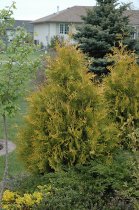Thuja occidentalis Yellow Ribbon Tree
 Thuja occidentalis 'Yellow Ribbon'
Thuja occidentalis 'Yellow Ribbon'
Thuja occidentalis 'Yellow Ribbon' in fall
Height: 10 feet
Spread: 5 feet
Sunlight:
Hardiness Zone: 3a
Other Names: Eastern Arborvitae, American Arborvitae
Description:
A compact, upright evergreen shrub featuring dense foliage emerging orange and turning green over the summer; ideal size for small-scale articulation and as a garden color accent, hardy and adaptable; best with some sun, protect from drying winds
Ornamental Features:
Yellow Ribbon White Cedar has attractive gold foliage. The scale-like leaves are ornamentally significant and turn an outstanding harvest gold in the fall. Neither the flowers nor the fruit are ornamentally significant. The shaggy indian red bark is not particularly outstanding.
Landscape Attributes:
Yellow Ribbon White Cedar is a dense multi-stemmed evergreen shrub with a narrowly upright and columnar growth habit. Its relatively fine texture sets it apart from other landscape plants with less refined foliage.
This is a relatively low maintenance shrub. When pruning is necessary, it is recommended to only trim back the new growth of the current season, other than to remove any dieback. It has no significant negative characteristics.
Yellow Ribbon White Cedar is recommended for the following landscape applications;
- General Garden Use
- Accent
- Hedges/Screening
- Vertical Accent
Plant Characteristics:
Yellow Ribbon White Cedar will grow to be about 10 feet tall at maturity, with a spread of 5 feet. It tends to fill out right to the ground and therefore doesn't necessarily require facer plants in front, and is suitable for planting under power lines. It grows at a slow rate, and under ideal conditions can be expected to live for approximately 30 years.
This shrub does best in full sun to partial shade. It prefers to grow in average to moist conditions, and shouldn't be allowed to dry out. It is not particular as to soil type or pH. It is somewhat tolerant of urban pollution, and will benefit from being planted in a relatively sheltered location. Consider applying a thick mulch around the root zone in winter to protect it in exposed locations or colder zones.
You might also like





